Editor’s Note: Shortly before we went to press, Kevin Babington suffered a serious spinal-cord injury from a fall while competing his grand prix partner Shorapur, who was not injured. For updates on Kevin’s condition and for more about fundraising efforts, please see “Babington Strong,” our feature on the Babingtons in the Summer 2020 issue.
You turn the corner and approach the jump. Suddenly your horse gains speed and grabs the bit as he makes a bid for the fence. You try to slow him by pulling back on the reins and sitting deep, but he ignores your aids and continues to increase his momentum. You can’t see a distance, and on the takeoff, your horse either launches himself at the fence from a long distance, jumping it very flat, or at the last second, fits in a small stride and fumbles over it.
You’re riding a rusher. At best you feel disorganized, and at worst you have zero control and sometimes are even afraid. You are losing confidence and worry your horse’s confidence is also at risk.
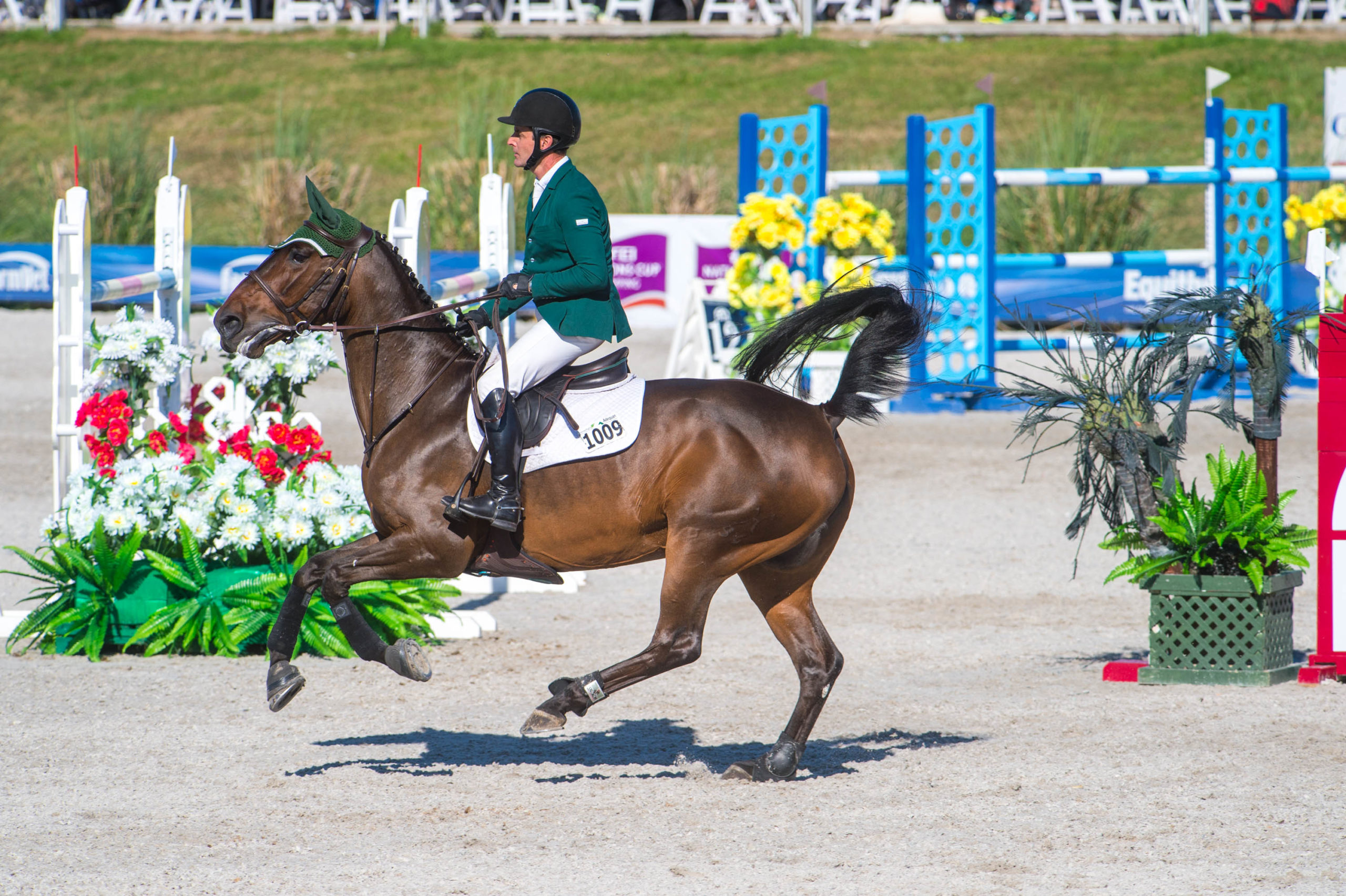
Amy K. Dragoo
The most common reason a horse rushes is because he is crooked, unbalanced or both. When a horse is crooked or unbalanced, he lacks the strength to carry his weight evenly on both hind legs, which means he does not have the power to clear the jump confidently. Instead, he uses speed as a way to make it to the other side. A straight horse, on the other hand, travels on two tracks with each hind foot following the track of its corresponding forefoot, whether on a straight or curved line. He accepts equal contact on both reins instead of leaning on or having stiffness on one rein. His weight is distributed evenly across his four legs. This allows him to push off his hind legs evenly when jumping, helping him produce a strong, correct jump.
The key to stop a horse from rushing is to change his balance without taking away his impulsion. Many riders, however, think the solution to slowing down a horse who rushes is to go to a stronger bit or start pulling on the approach to the jump to slow him down. This often compounds the problem because the ride quickly becomes a tug of war—and the horse is much stronger!
I’ll show you my method for correcting a horse who rushes—first by making sure he is straight and can travel on two tracks and then by adjusting his balance on the flat and then over a small cavalletti exercise.
Before we begin, it’s always a good idea to rule out any physical issues with your veterinarian before you try to address the problem with training. It’s possible that your horse could be running away from pain. However, I think many people are too quick to go to the vet to look for the magic solution. More often than not, it just takes correct riding.
Traveling Straight on Two Tracks
Before you start to work on your horse’s straightness, make sure you are centered—sometimes riders are naturally one-sided. They also often twist their bodies, get tense or end up crooked in the saddle from years of trying to deal with a horse who’s stiff on one rein. Sit square with equal weight in both stirrups, seat bones and reins so you aren’t contributing to or causing your horse’s crookedness.
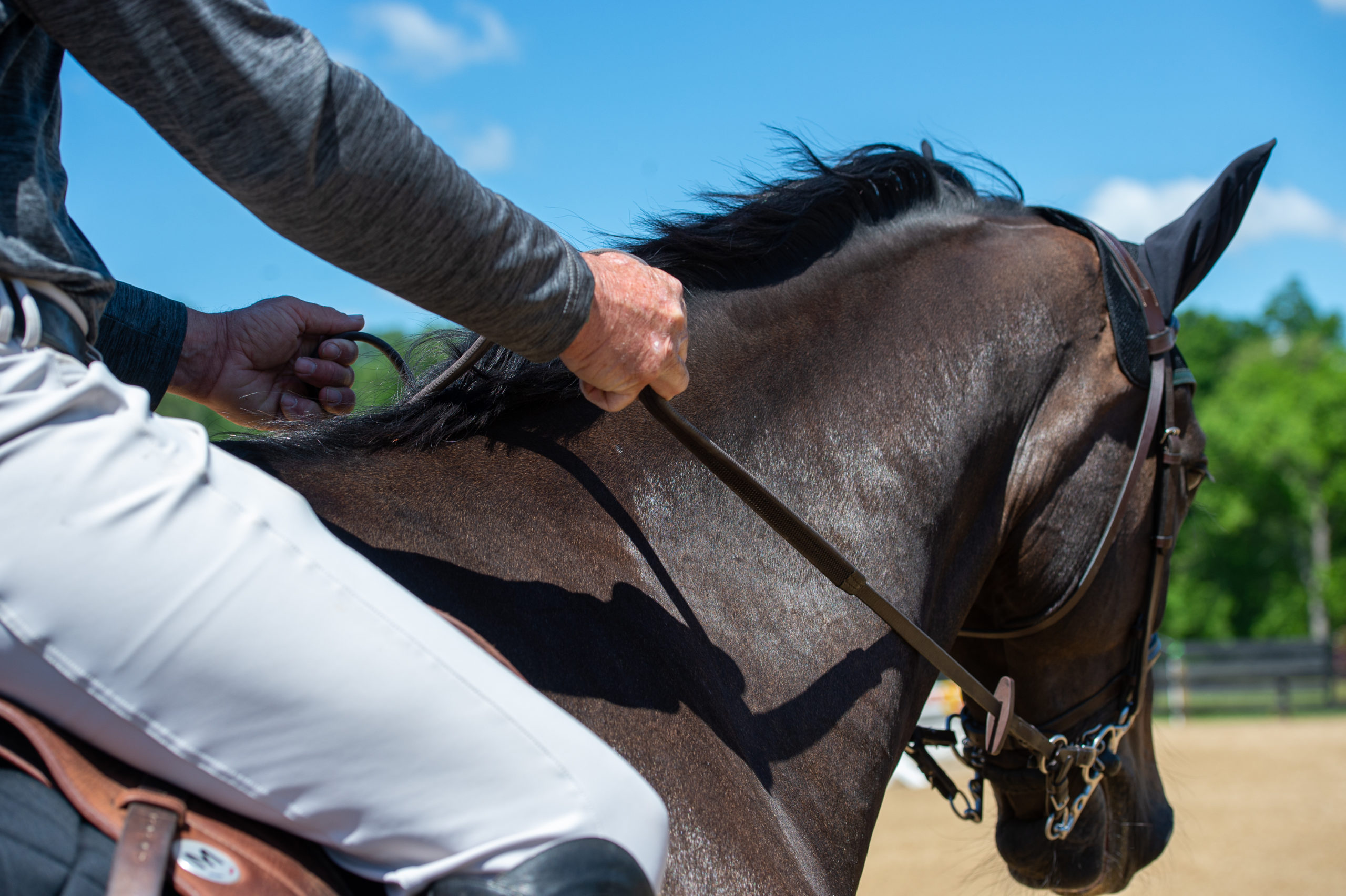
Amy K. Dragoo
Like riders, many horses are naturally one-sided and stronger on one side than the other—one of the most common causes of crookedness. A tell-tale sign that your horse is crooked is if he leans on one rein. When he does this, he avoids taking contact on the opposite rein and avoids carrying weight on the opposite hind leg. So, for example, a horse who leans on the left rein is avoiding taking contact on the right rein and is not carrying weight on his right hind leg, which then swings out to the right.
To test this, think about a funnel shape going from his mouth and bit to your hands. Your hands are the widest part of the funnel and the bit is the narrowest part. As you work on the flat, look down at your horse’s shoulders and make sure his left shoulder and the left rein are the same amount of space apart as his right shoulder and the right rein. If they are, it’s a good sign that your horse is traveling with his shoulders straight and his hind end is falling into alignment. If you see that his left shoulder wants to be up against the left rein (and widest part of the funnel), it’s a sign that your horse is leaning on the left rein, dropping his left shoulder and swinging his haunches to the right. This means he is also putting less weight or is weaker on the right leg.
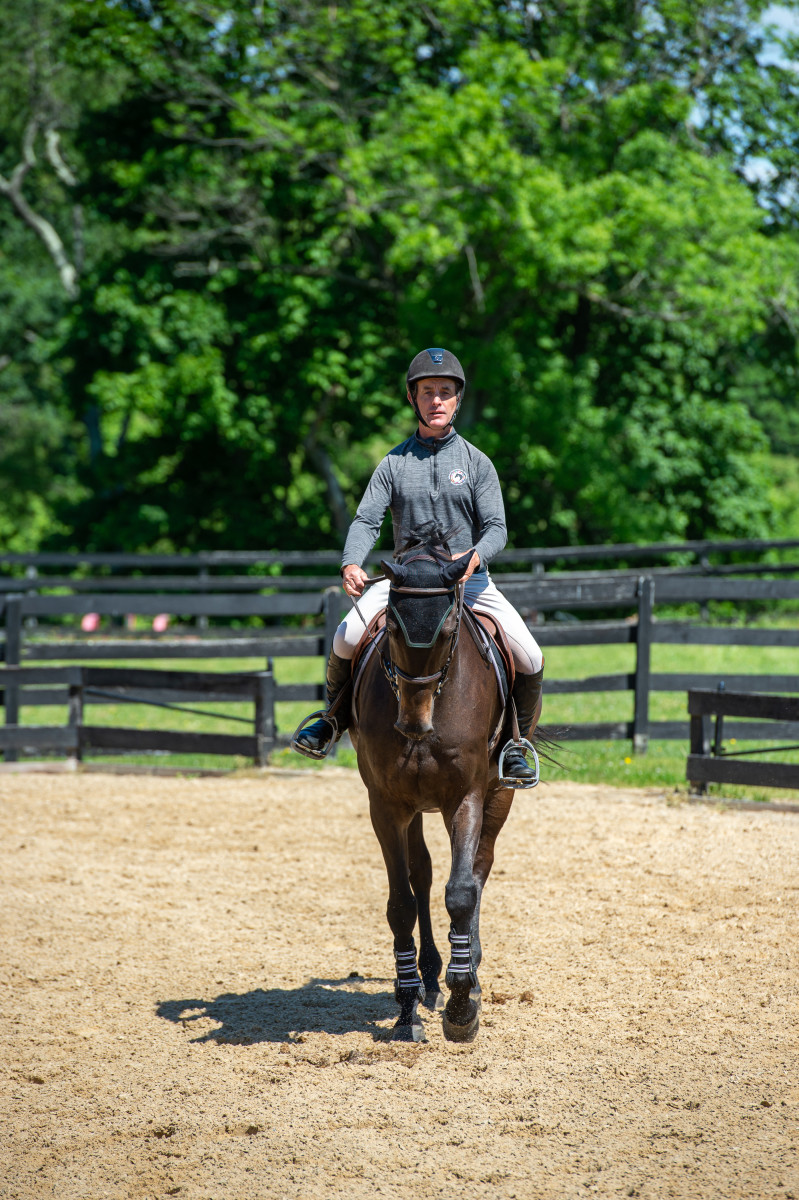
Amy K. Dragoo
If your horse is crooked, the goal is to get him to take the contact on the rein he is avoiding, which will help bring his shoulders in line with his haunches for straightness. Horses tend to be less tense or flighty when you move their shoulders versus their haunches. You can still support or help with your leg but focus on controlling the shoulders.
So in the example above, if your horse leans on the left rein, start by tracking left at the walk because it’s a little easier for the rider to make the correction on the inside rein than the outside. Start by using an opening right rein: Imagine you are holding a serving tray and have to move both hands together on the same plane. Without changing the space between your hands, move both of them a little to the right. This will encourage your horse to accept some contact on the right rein, raise his left shoulder and move both shoulders to the right to fill the gap, closing the distance between your right rein and his right shoulder. Once your horse takes the contact on the right rein, allow him to bend to the left by following his mouth a little with the right hand. If you have too much weight in your right hand, you could block him and force him back onto his left shoulder. Lifting the left shoulder and getting the horse to bend around your left leg is what creates a solid contact on the right rein. The result is a horse who puts more weight on to the right hind leg.
After you master getting your horse to travel on two tracks at walk, try it at the trot and then canter. You will use the same aids except in the canter where you can use your seat bones a little more to influence the horse. At the canter, be extra conscious about sitting in the center of your horse because a crooked horse will try to displace you off to the side, affecting the balance even more.
For instance, if you are cantering to the left on a horse who is stiff on the left rein and weak on his right hind leg, when you stop the left shoulder from falling in, you will feel the horse bring his weight over his right hind leg and be able to feel the difference in your right seat bone. When you feel the difference in your seat bone, ease up the pressure on the left rein.
Once your horse is traveling straight on two tracks, you can work on asking him to carry more weight on his hind legs evenly.
Balance Him on His Hind End
To practice putting more weight onto your horse’s hind legs, at the walk increase your leg aids so that your horse is marching forward and the energy is coming from behind. Sitting quietly, raise both hands, maintaining the connection from the bit to the elbow. This will elevate his withers and allow him to carry more weight on his hind legs. At this point, most horses will become lighter in your hand and want to stretch into a more natural frame and lift their backs because they’re in balance. When you feel this balance, allow your horse to use his neck and stretch as a reward by lowering your hand and following his mouth.
When first learning this technique, it helps to have an educated eye on the ground to communicate when to soften. When the helper sees the horse take weight onto the hind legs, she can remind you to soften your hands and follow your horse as he stretches. Soon you will develop that feeling on your own. A common mistake is when your horse goes to stretch, you continue to ask him to shift his weight back. This quickly becomes a pressure cooker situation, which will make your horse tense and confused. Riding is all about pressure and reward. The timing of the reward is important in anything you do with horses, but it is especially important in this exercise. Once your horse is shifting his balance back at the walk, practice the exercise at the trot and then the canter.
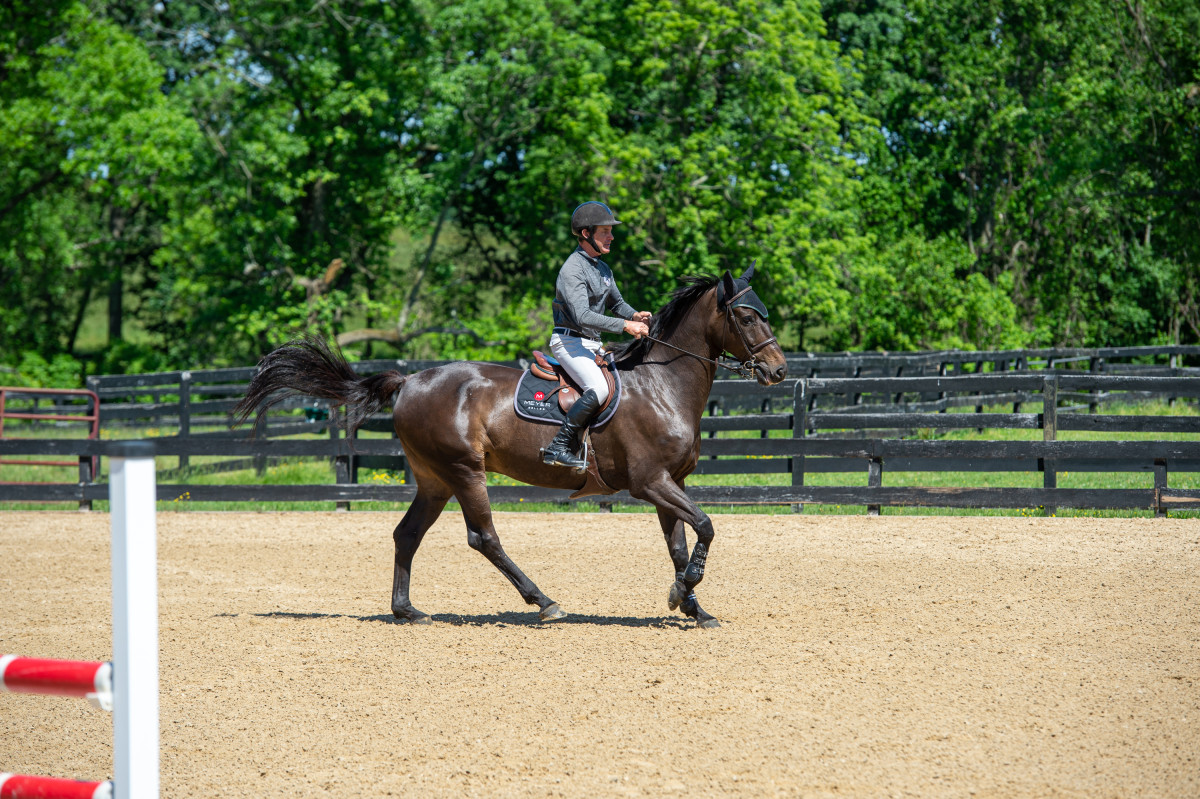
Amy K. Dragoo
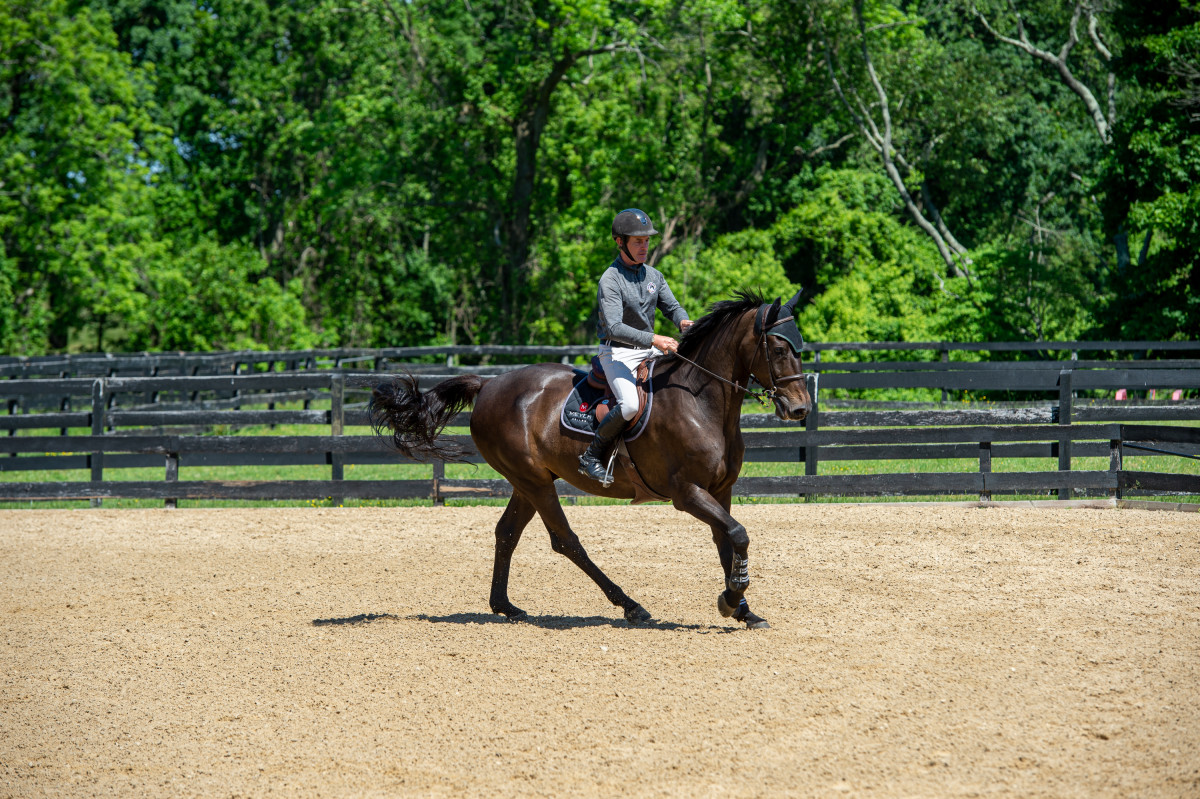
Amy K. Dragoo
If your horse has a high head carriage, carry your hand almost higher than he wants to carry himself to achieve a connection from the bit to your elbow. Once you have done that, raise your hand a little more to help him put his weight on the hind legs. As soon as a high-headed horse shifts his weight back, he will always want to drop his head and soften his back and, therefore, can produce a better jump. The biggest mistake to make if your horse does raise his head carriage is to lower your hand to try to pull his head down—it doesn’t work. He is stronger than you.
For a horse who pulls down, you also want to raise your hand to encourage him to shift his weight to his hind end. Again, when you feel his forehand come up and he sits, you have to give with your hand to encourage the horse to carry himself. When a horse pulls down, many riders will go to a stronger bit, but I encourage them to learn proper technique with their hands instead. For instance, the reason riders put a gag bit in the horse’s mouth is for more control. When a rider pulls back, the gag rises up in the horse’s mouth which helps pick up his head—and when you pick up the head, the weight goes on the hind legs. Why not just lift your hand to achieve the same result? Putting on a pair of draw reins or a stronger bit doesn’t address the problem. The reason why your horse is rushing in the first place is because he’s weak on one hind leg and he’s out of balance. It’s important to understand how to change the horse’s balance rather than pulling on the bars of the mouth to slow him down, which can quickly become a game of tug of war.
A horse who is very much on his forehand is telling you that he’s finding it physically hard to carry himself. After you get in some good strides give your horse a break and then ask again. If he can’t naturally go five strides in a good balance, then you can’t expect him to go 100 strides in that balance without it being an issue. This is not something that’s going to develop overnight—you have to know his capability and work to increase his strength over time.
Cavalletti for Straightness
To practice keeping your horse straight and on his hind end to fences, start with a simple cavalletti exercise. Set up two cavalletti placed five strides (60 feet) apart in the middle of the ring. On each cavalletti, place two ground poles so that they form a “v.” Set the narrowest part wider than the horse’s shoulders and resting on the cavalletti and the widest part on the ground. These poles will act as guide rails, or a funnel, to remind you to focus on staying straight and will encourage your horse to jump the middle of both cavalletti.
Tracking right, canter down the long side in a big, forward canter. If your horse’s tendency is to be weak on the right hind leg, think shoulder-in at the canter right before you turn onto your line to help distribute the weight on to the hind leg.
Before you turn onto your line, think about riding a little bit of a square turn while maintaining a good rhythm. But don’t overdo it, because trying to square up the turn too much can take away from the canter and break the rhythm, which makes the jumping effort much harder on the horse.
As you turn down centerline, think about sitting very straight and keeping your outside shoulder back. If you follow too much with your outside shoulder, you give with your outside rein which allows him to pop through his outside shoulder.
Keep your eye on the cavalletti line and focus on executing two actions—a balancing action by lifting the outside rein and a shoulder-blocking action by opening the inside rein and using a slight outside neck rein. This raises your horse’s withers and distributes the weight on to his hind legs so he can more easily bring his shoulders around his inside hind leg. Simply pulling or turning with the outside rein doesn’t work because it doesn’t encourage the horse to balance on his hind leg.
Canter over the cavalletti line in five easy strides with a light contact. If your horse wants to pop his shoulder to the left, draw the left rein directly back toward you to block the left side, move his shoulders to the right and put a little more weight onto the right hind leg. Be careful to not be stiff or pull because that will cause him to lose forward momentum. Your right leg supports your horse’s hip and prevents it from moving right.
Once the five-stride line feels comfortable, canter the line in six strides to practice balancing his weight on his hind legs by raising your hands. This exercise is not about shortening your horse’s stride or slowing down; it’s to get him to rock back and change his balance. Like before, focus on your horse’s straightness first, then think about bringing his withers up.
Teaching a horse to consistently travel straight on two tracks can take several sessions and it may take some time to develop the feeling to manipulate his balance on the approach to a jump. However, your horse will soon learn he doesn’t need to run at jumps to make it over. Remember, stopping a horse from rushing is more about understanding the technique in your riding as opposed to using strength and force.
Sidebar: Build Strength
Strength-wise, it’s actually quite difficult for horses to travel totally straight for a long period of time. To build up your horse’s strength, which will in turn help his balance, ride outside your ring occasionally. Find a field or track where you can work on staying straight for longer durations. Every once in awhile look down to check the space between his withers and the reins to see if he’s straight.
About Kevin Babington
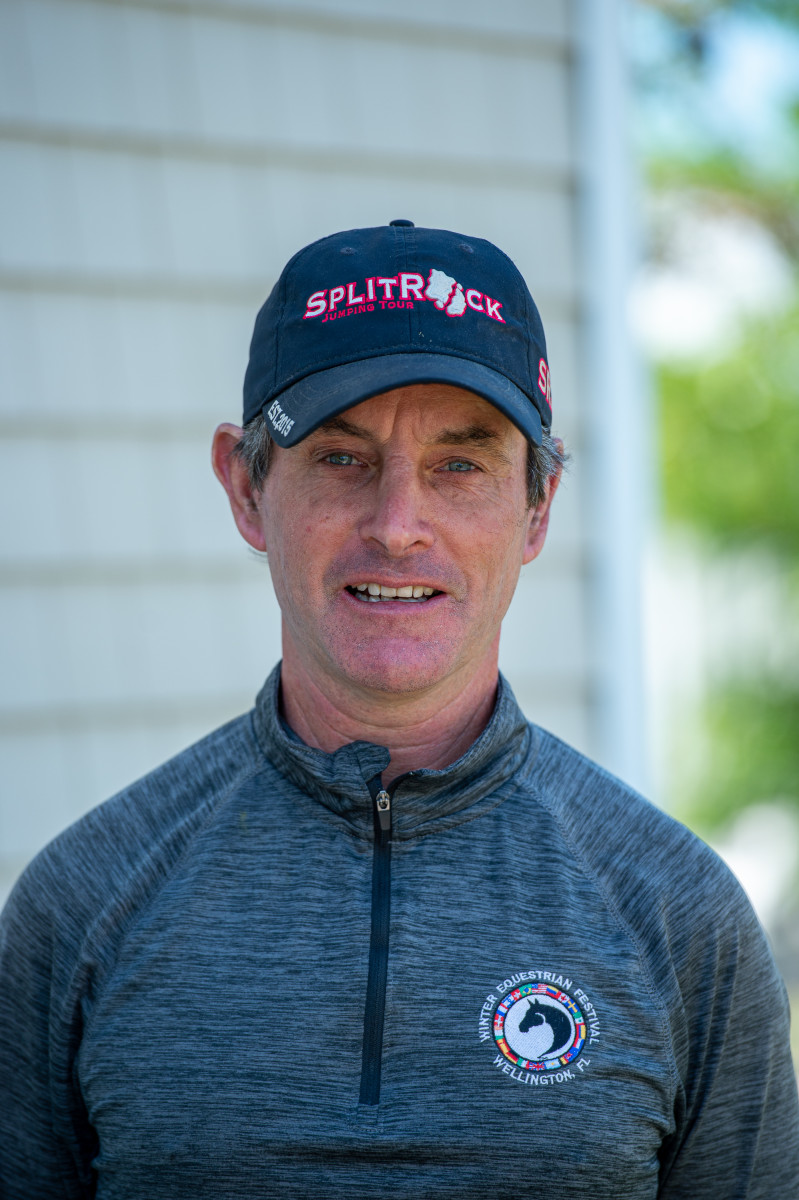
Kevin Babington began riding in his native Ireland at age 11. He foxhunted and participated in Pony Club before training with Irish show-jumping veteran Iris Kellett and earning his British Horse Society instructor accreditation. Kevin then moved to the United States, where he worked for Frank and Mary Chapot for several years.
In 2000, one of Kevin’s students, amateur jumper Saly Glassman, gave him the opportunity to ride the phenomenal Irish Sport Horse gelding Carling King. The pair went on to represent Ireland in numerous international competitions earning, among many other honors, 12 Nations Cup team wins, individual eighth place at the 2002 World Equestrian Games and individual fourth place in the 2004 Olympics. Kevin continued to train and compete top-level jumpers—including Mark Q and Shorapur with whom he has numerous grand prix wins and placings.
This article originally appeared in the Fall 2019 issue.










